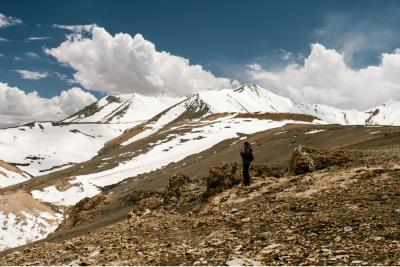Snow Droughts are Not Solely Driven by Abnormal Snowfall and Temperature
Decreased snow cover observed over the past few decades and projected for the future suggest increasing snow droughts that threaten water security and management. While various observational data products and model simulations are available to study snow droughts, a comparison between them has been lacking. This study compared different numerical experiments using the Energy Exascale Earth System Model (E3SM) and reference data from the climate dataset ERA5-Land to understand the drivers of snow droughts in 1980–2014. Analysis revealed multiple factors contributing to snow droughts and underscores the need for a more comprehensive understanding of the drivers of snow droughts to reduce uncertainty in projecting their future changes.
This study revealed well-recognized factors like above-normal temperature and low snowfall contribute to the occurrence of snow droughts. The study also showed other contributors such as low soil moisture, warm soil temperature, and low relative humidity play important roles in the occurrence of snow droughts. The study highlights the exacerbating effect of changing climate patterns, known as El Niño-Southern Oscillation (ENSO) events, on snow drought conditions in various regions. By comparing E3SM simulations and ERA5-Land data, this study identified some model shortcomings and underscores the complexity of predicting and mitigating snow drought and the need for a comprehensive understanding of the factors contributing to snow drought.
Understanding the threat that snow droughts pose to water security and management is crucial, which is why the study of snow droughts is important. In this study, we analyzed snow droughts using offline and coupled land–atmosphere E3SM model results and compared them with reference data derived from ERA5-Land, which fills the gap of limited global and systematic data–model comparisons. Our study showed that the occurrences of snow drought are predominantly due to low snowfall, warm temperature, or both. However, about 20–30% of snow droughts in our analysis can occur due to factors such as low soil moisture, warm soil temperature, and low relative humidity. Due to the lack of consensus on whether ENSO induces or relieves drought in snowpack conditions, we examined snow droughts in ENSO for the years between 1980 and 2014. Our study showed that ENSO events can aggravate snow droughts in various regions. Specifically, El Niño events were found to potentially prolong snow droughts in Russia, whereas La Niña events may contribute to extended snow droughts in Central Asia. Therefore, it is important to consider all the factors that contribute to drought conditions besides temperature and snowfall conditions. It is also important to consider the local conditions and how they interact with larger climate patterns associated with modes of climate variability such as ENSO to fully understand the causes of snow drought.

